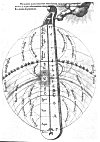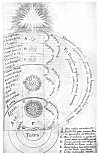
Sacred Texts Earth Mysteries Index Previous Next

IT WAS HIS PROLONGED OBSERVATION of the movement of Mars (Fig. 95) that led Kepler to discover the true form of the planetary orbits, till then considered to be perfectly circular, and it was during the last year of his observations (1596) that he hit upon his beautiful "solution" of the "cosmographic mystery." He believed in the harmony of the spheres, and all his life he sought for some true and simple law binding the members of the solar system together. His first step was to discover the law connecting the relative distances of the planets, some simple ratio of distances that would do away with the complex and multiplied epicycles and excentrics with which Ptolemy and his successors had troubled, if not the heavens,

Click to enlarge
PLATE XL. THE MUNDANE MONOCHORD
(From Utriusque Cosmi: Robert Fludd, 1621. Vol. I)
the minds of men. By accident he was brought finally to seek this law of distances through simple geometry. A diagram he had drawn during a lecture, to illustrate the cycles of the great conjunctions of the planets, reminded him, in a sudden flash of illumination, of the "five regular solids," the "five mathematical bodies" (-6); and for the rest of his life he worked on the theory that these beautiful solids bore within themselves a proportion answering to the several distances of the planets from each other. That is, if we describe a circle around a cube and another inside it, or a circle about a tetrahedron and another within it, the distances between these circumscribed and inscribed circles will show the proportional distances of the planets each from the other between which these five solids fit.
Between the six planetary spheres there are five intervals, and Kepler placed the five solids between the spheres as follows:
|
Saturn |
That is, the sphere of Jupiter is inscribed in a cube to which the sphere of Saturn is circumscribed; the sphere
of Jupiter is circumscribed to a tetrahedron in which the sphere of Mars is inscribed, and so on. The rest is mathematics.
In Kepler's beautiful drawings of his solids (), which, more than plane figures, he said, must belong to Space, he assigned to each form that one of the great elements whose "component particle" corresponded. Within a crystalline cube he placed a mountain, a tree, a sprouted and leafing plant, and tools for tilling the Earth. Within the tetrahedron he placed fire; within the dodecahedron the firmament; within the icosahedron water and the inhabitants of water; within the octahedron "flying birds."
Kepler's "intervals" were not only spaces for the five mathematical bodies; they were also "notes" in an harmonic universal scale. His harmony of the spheres was not only the harmony of movement but the result of movement--sound. It was unimaginable that the grand revolutions of the spheres through Space were made in silence; unimaginable also that the ears of men could hear the prodigious concert of the whole universe in its rapid revolution. As they must close their eyes against the Sun, too bright to see, so must their ears be closed against a harmony too vibrant to endure.
Yet, if the ears of man may not hear the music of the spheres, his eyes may follow the paths of celestial sound, said Robert Fludd, and straightway began to "draw" the music of the spheres. "This," he wrote at the top of the first figure of his series of World Octaves, in his Musica Mundana (Plate XL), "is the world monochord, with its

Click to enlarge
PLATE XLI. MAN AND THE WORLD OCTAVE
(From Utriusque Cosmi; Robert Fludd, 1621. Vol. I)
proportions, harmonies and intervals of its extra-mundane movement accurately spaced as herein depicted." Earth--the mute because motionless Earth of the Pythagoreans--plays its part through the division of the elements, Earth, Water, Air, and Fire. Only when the Earth's atmosphere reaches the zone of the Moon is the first note struck of the great C major scale. Beyond the seven zones of the Moon, the Sun, and the five planets, and above the firmament of the fixed stars, the divisions of the upper heavens correspond to those of the Earth below.
Plate XLI is the second of the series, taken up again in his Microcosmi Historia, in which man is shown as participator in the heavenly scale. Here is a single octave, instead of two, as in the preceding drawing; its scale given in terms of mind or reason, rather than in terms of the elements and the heavenly bodies. From A, the Absolute Mind or Essence of the Godhead, or Unity, or Spirit, it descends through B, the creative or active intellect, the first vehicle of the mind, to C, mind and intellect in the rational spirit (or the passive intellect), to D, the rational spirit together with mind and intellect in the median soul, to E, the median soul floating in the aethereal liquid (in other words, the Living Light combined with Mind), to F, the Body (or man), which is the receptacle of all things.
And then, having given the two-octaved universe--Heaven and Earth, and the one-octaved universe stretching from the Godhead to man, he drew a third figure (Plate XLII) of the three-octaved universe, with its three
great scales of correspondences, rising one above the other, each corresponding exactly, note by note, to the other two, whether higher or lower. Sound, he says, is the connecting link between the three worlds; for sound is the language of the mind. Vibration is the secret of creation, and through it all secrets may be revealed, if the sleeping mind and memory of man is ever wakened through its power.